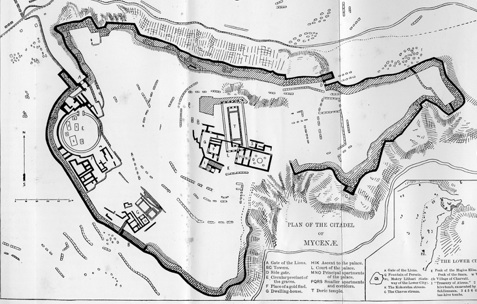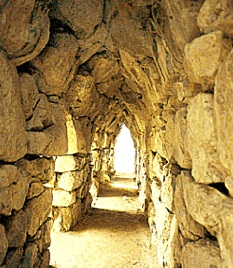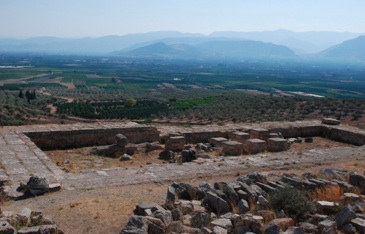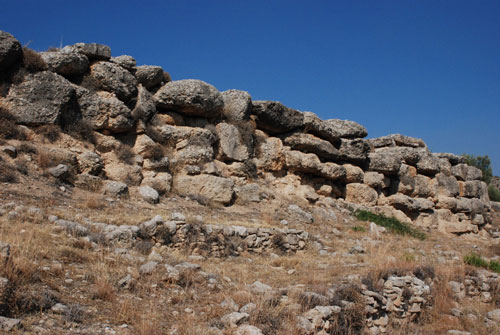Cyclopean masonry is a term used to describe a type of megalithic architecture entailing the working of unusually large blocks of stone, often for the construction of fortifications. The term was coined by Greeks in the Classical Age, reflecting the belief that only the Cyclops, gigantic, one-eyed creatures of myth, could have been strong enough to manipulate stones so immense.
DEVELOPMENT AND HISTORY
Cyclopean masonry, developed by the Mycenaean Civilization of Greece (more specifically, during the Late Helladic IIIA – IIIB, c. 1425 – 1190 BCE) stands in stark contrast to the types of construction favored by earlier Greek civilizations. The Minoans, for instance, known for their spectacular palace complexes on Crete, used post-and-lintel construction almost exclusively. The residents of Mycenaean citadels, however, found it necessary to build far greater fortifications than yet excavated on Crete. This need for security led to the use of Cyclopean masonry when constructing the extensive citadel walls enclosing the territory around Mycenaean palaces.
MYCENAEAN EXAMPLES
The most striking examples of Cyclopean masonry from the Mycenaean period come from the citadels at Mycenae and Tiryns. Mycenae provides a perfect illustration of the typical use of Cyclopean masonry. The citadel walls are constructed of gigantic blocks of stone, some reaching eight meters in thickness (Biers, p. 67). Mycenae is known for the three-stage construction of its walls. The first stage enclosed the central area of the citadel. Next, the walls were expanded to create the Lion Gate, and to include Grave Circle A at the eastern edge of the fortress. Finally, a small expansion was made at the citadel’s northwestern corner to provide access to a secret spring, a source of water for the Mycenaeans should they ever be besieged. The cyclopean fortifications of Mycenae served to protect this precious resource. The construction of the Lion Gate of Mycenae demonstrates the way in which Cyclopean masonry interacted with other types of stonework. At this gate, the cyclopean fortifications are broken by an insertion of blocks worked with the ashlar technique, which makes the blocks lie in straight horizontal lines. The elegance of ashlar work seems to be reserved for this area around the gate. Most of the walls themselves remain Cyclopean.

Plan of the citadel at Mycenae
At Tiryns, Cyclopean masonry is used in an entirely revolutionary way. Although the fortress is enclosed with a wall apparently similar to that at Mycenae, the 10 meters or more thickness of the walls at Tiryns hide a secret. They are constructed in two parallel layers, leaving a hidden space in between, which would probably have been used for some sort of storage. On the outside, the walls would appear to be normal, Cyclopean fortifications.

The walls at Tiryns
LATER USES
Although Cyclopean masonry was generally a Late Helladic means of construction, it did occasionally appear later in Greek history. This is best demonstrated by the Geometric (900 – 700 BCE) terrace at the Argive Heraion, one of many temples constructed at the edge of a Greek city-state, possibly as a means of defining its territory. This terrace is unlike any other architecture from this period. It is Cyclopean, constructed from blocks of stone two meters tall and more quarried from a large stone outcrop behind the terrace, and could be seen from the Larissa in Argos. The construction of this terrace, in a style so connected with an earlier time, has been read as an attempt by Argos to lay claim to the Mycenaean past as a way of solidifying Argive power in the present. Lending credence to this interpretation is the presence of a large Mycenaean cemetery just behind the Heraion.

The Cyclopean terrace at the Argive Heraion
Return to Glossary of Key Terms

Posted at Dec 10/2007 08:36AM:
chris witmore: Hi Harry,
Here is a shot of the so-called Old Temple Terrace at the Heraion. It is actually behind the camera in the shot of the temple foundation with the plain in the background.
Posted at Dec 13/2007 11:25PM:
Harry Anastopulos: I'm always impressed by how ancient peoples can create such marvelous things out of such large and unwieldy building materials. I'm sure the term "Cyclopean" itself comes from the wonder that later peoples must have felt at the sight of many of these structures!
